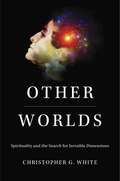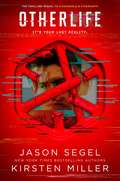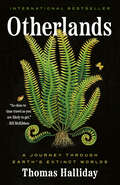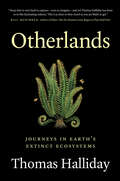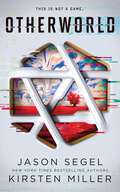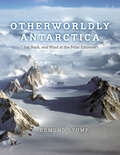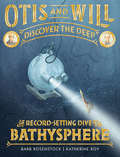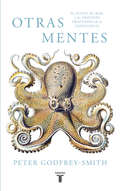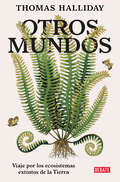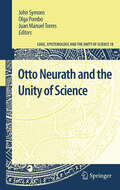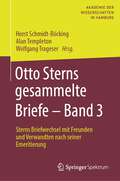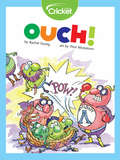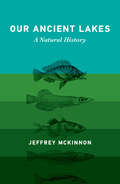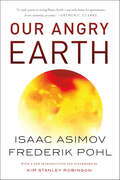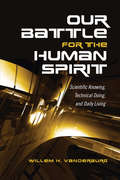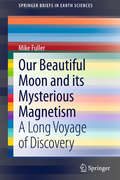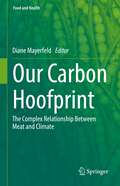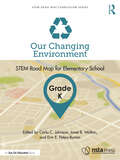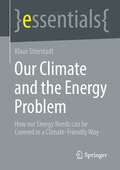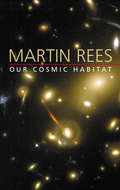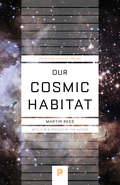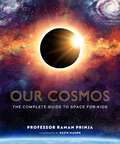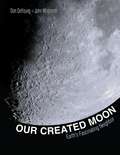- Table View
- List View
Other Senses, Other Worlds
by Doris Jonas David JonasScientific evidence now substantiates science fiction fantasies: we will meet alien beings on other planets--possibly in our own solar system, surely in other galaxies. What shapes will they take? What kinds of intelligence can we expect? How will we communicate? Here two scientists provide authoritative speculation on the nature of extra-terrestrial life, beginning their investigation with a survey of sensory perception on earth--not just our five senses, but the senses we lack that are found in other forms of life. Based on accepted facts about the environments of other planets they have created fascinating and indeed probable scenarios for a whole range of other worlds, complete with intelligent life forms, social structures, and life-styles.
Other Worlds: Spirituality and the Search for Invisible Dimensions
by Christopher G. WhiteWhat do modern multiverse theories and spiritualist séances have in common? Not much, it would seem. One is an elaborate scientific theory developed by the world’s most talented physicists. The other is a spiritual practice widely thought of as backward, the product of a mystical world view fading under the modern scientific gaze. But Christopher G. White sees striking similarities. He does not claim that séances or other spiritual practices are science. Yet he points to ways that both spiritual practices and scientific speculation about multiverses and invisible dimensions are efforts to peer into the hidden elements and even the existential meaning of the universe. Other Worlds examines how the idea that the universe has multiple, invisible dimensions has inspired science fiction, fantasy novels, films, modern art, and all manner of spiritual thought reaching well beyond the realm of formal religion. Drawing on a range of international archives, White analyzes how writers, artists, filmmakers, televangelists, and others have used the scientific idea of invisible dimensions to make supernatural phenomena such as ghosts and miracles seem more reasonable and make spiritual beliefs possible again for themselves and others. Many regard scientific ideas as disenchanting and secularizing, but Other Worlds shows that these ideas—creatively appropriated in such popular forms as C. S. Lewis’s Chronicles of Narnia, the art of Salvador Dalí, or the books of the counterculture physicist “Dr. Quantum”—restore a sense that the world is greater than anything our eyes can see, helping to forge an unexpected kind of spirituality.
OtherLife: Last Reality Series
by Kirsten Miller Jason SegelThe eagerly anticipated third instalment in the fast-paced Last Reality series Simon, Kat, Busara, and Elvis are on the run with the tech super-villains at the Company hot on their heels. The new VR gaming experience the Company created, OtherEarth, is set to change how the world experiences video games. Paired with the hardware the Company developed, it has the potential to change the world as we know it, altering our reality forever. The Company is on its way to becoming the world's newest superpower. And Simon is determined to shut them down forever. But to do that, he'll have to survive OtherLife – the next phase of gaming, and a complete reality reboot.
Otherlands: A Journey Through Earth's Extinct Worlds
by Thomas HallidayThe past is past, but it does leave clues, and Thomas Halliday has used cutting-edge science to decipher them more completely than ever before. In Otherlands, Halliday makes sixteen fossil sites burst to life on the page. <p><p> This book is an exploration of the Earth as it used to exist, the changes that have occurred during its history, and the ways that life has found to adapt―or not. It takes us from the savannahs of Pliocene Kenya to watch a python chase a group of australopithecines into an acacia tree; to a cliff overlooking the salt pans of the empty basin of what will be the Mediterranean Sea just as water from the Miocene Atlantic Ocean spills in; into the tropical forests of Eocene Antarctica; and under the shallow pools of Ediacaran Australia, where we glimpse the first microbial life. <p><p> Otherlands also offers us a vast perspective on the current state of the planet. The thought that something as vast as the Great Barrier Reef, for example, with all its vibrant diversity, might one day soon be gone sounds improbable. But the fossil record shows us that this sort of wholesale change is not only possible but has repeatedly happened throughout Earth history. Even as he operates on this broad canvas, Halliday brings us up close to the intricate relationships that defined these lost worlds. <p><p> In novelistic prose that belies the breadth of his research, he illustrates how ecosystems are formed; how species die out and are replaced; and how species migrate, adapt, and collaborate. It is a breathtaking achievement: a surprisingly emotional narrative about the persistence of life, the fragility of seemingly permanent ecosystems, and the scope of deep time, all of which have something to tell us about our current crisis.
Otherlands: Journeys in Earth's Extinct Ecosystems
by Thomas HallidaySapiens for natural history: a stirring, eye-opening journey into deep time, from the Ice Age to the first appearance of microbial life 550 million years ago, by a brilliant young paleobiologist.The past is past, but it does leave clues, and Thomas Halliday has used cutting-edge science to decipher them more completely than ever before. In Otherlands, Halliday makes sixteen fossil sites burst to life on the page.This book is an exploration of the Earth as it used to exist, the changes that have occurred during its history, and the ways that life has found to adapt-or not. It takes us from the savannahs of Pliocene Kenya to watch a python chase a group of australopithecines into an acacia tree; to a cliff overlooking the salt pans of the empty basin of what will be the Mediterranean Sea just as water from the Miocene Atlantic Ocean spills in; into the tropical forests of Eocene Antarctica; and under the shallow pools of Ediacaran Australia, where we glimpse the first microbial life. Otherlands also offers us a vast perspective on the current state of the planet. The thought that something as vast as the Great Barrier Reef, for example, with all its vibrant diversity, might one day soon be gone sounds improbable. But the fossil record shows us that this sort of wholesale change is not only possible but has repeatedly happened throughout Earth history.Even as he operates on this broad canvas, Halliday brings us up close to the intricate relationships that defined these lost worlds. In novelistic prose that belies the breadth of his research, he illustrates how ecosystems are formed; how species die out and are replaced; and how species migrate, adapt, and collaborate. It is a breathtaking achievement: a surprisingly emotional narrative about the persistence of life, the fragility of seemingly permanent ecosystems, and the scope of deep time, all of which have something to tell us about our current crisis.
Otherworld: Last Reality Series (Last Reality Ser. #1)
by Kirsten Miller Jason Segel"Full of high stakes, thrillers, and fantastic twists and turns, fans of Ready Player One are sure to love this addictive read." —BUZZFEED Welcome to real life 2.0. Are you ready to play? There are no screens. There are no controls. You don&’t just see and hear it – you taste, smell, and touch it too. In this new reality there are no rules to follow, no laws to break. You can live your best life. It&’s a game so addictive you&’ll never want it to end. Until you realize that you&’re the one being played. Step into Otherworld. Leave your body behind. The frightening future that Jason Segel and Kirsten Miller have imagined is not far away. Otherworld asks the question we'll all soon be asking: if technology can deliver everything we want, how much are we willing to pay?
Otherworldly Antarctica: Ice, Rock, and Wind at the Polar Extreme
by Edmund StumpWith stunning original photographs, an Antarctic scientist and explorer takes us to one of the most sublime, remote, and pristine regions on the planet. The interior of Antarctica is an utterly pristine wilderness, a desolate landscape of ice, wind, and rock; a landscape so unfamiliar as to seem of another world. This place has been known to only a handful of early explorers and the few scientists fortunate enough to have worked there. Edmund Stump is one of the lucky few. Having climbed, photographed, and studied more of the continent-spanning Transantarctic Mountains than any other person on Earth, this geologist, writer, and photographer is uniquely suited to share these alien sights. With stories of Stump’s forty years of journeys and science, Otherworldly Antarctica contains 130 original color photographs, complemented by watercolors and sketches by artist Marlene Hill Donnelly. Over three chapters—on the ice, the rock, and the wind—we meet snowy paths first followed during Antarctica’s Heroic Age, climb the central spire of the Organ Pipe Peaks, peer into the crater of the volcanic Mount Erebus, and traverse Liv Glacier on snowmobile, while avoiding fatal falls into the blue interiors of hidden crevasses. Along the way, we see the beauty of granite, marble, and ice-cored moraines, meltwater ponds, lenticular clouds, icebergs, and glaciers. Many of Stump’s breathtaking images are aerial shots taken from the planes and helicopters that brought him to the interior. More were shot from vantages gained by climbing the mountains he studied. Some were taken from the summits of peaks. Many are of places no one had set foot before—or has since. All seem both permanent and precarious, connecting this otherworld to our fragile own.
Otis and Will Discover the Deep: The Record-Setting Dive of the Bathysphere
by Katherine Roy Barb RosenstockThe suspenseful, little-known true story of two determined pioneers who made the first dive into the deep ocean.On June 6, 1930, engineer Otis Barton and explorer Will Beebe dove into the ocean inside a hollow metal ball of their own invention called the Bathysphere.They knew dozens of things might go wrong. A tiny leak could shoot pressurized water straight through the men like bullets! A single spark could cause their oxygen tanks to explode! No one had ever dived lower than a few hundred feet...and come back. But Otis and Will were determined to become the first people to see what the deep ocean looks like.This suspenseful story from acclaimed author Barb Rosenstock with mesmerizing watercolors by award-winning artist Katherine Roy will put you right in the middle of the spine-tingling, record-setting journey down, down into the deep.
Otras mentes. El pulpo, el mar y los orígenes profundos de la consciencia
by Peter Godfrey-SmithEl libro del año para mentes curiosas, lo más parecido a un encuentro alienígena. «Una fabulosa mezcla de encuentros a lo Cousteau con cefalópodos, apasionantes discusiones científicas y reflexión filosófica. Maravillosamente escrito, estimulante y audaz.» Olivia Judson, The Atlantic En una rama muy distante de la nuestra en el árbol de las especies surgió otra mente elevada: la de los cefalópodos. Pero, ¿qué clase de inteligencia poseen estos animales? ¿Cómo desarrolló tal inteligencia el pulpo, criatura de escasa vida social y longevidad de apenas dos años? Otras mentes es una nueva y audaz historia de cómo la naturaleza se hizo consciente de sí misma, un relato que transcurre en gran medida en el mar. Peter Godfrey-Smith, distinguido filósofo de la ciencia y hábil buceador, describe sus impresionantes encuentros con octópodos y las travesuras perpetradas por pulpos cautivos al tiempo que traza el asombroso viaje evolutivo de los cefalópodos, una ruta alejada de la que más tarde tomaríamos los mamíferos. Una inmersión profunda y excepcionalmente reveladora en los orígenes de la experiencia subjetiva. Críticas:«El tema es tan asombroso que es difícil no sentirse seducido, como le pasó al propio autor cuando le extendió una mano a un pulpo y éste se acercó para devolverle el toque, en clara señal de interés.»Irene Wanner, The Seattle Times «Fascinante. Después de leer este libro, parafraseando a Byron, "no amarás menos al hombre, sino más a los cefalópodos".»Callum Roberts, The Washington Post «El filósofo Godfrey-Smith combina hábilmente ciencia, filosofía y sus propias experiencias nadando entre estos animales tentaculares para iluminar el origen y la naturaleza de la conciencia.»The Economist «Godfrey-Smith se ha impuesto un doble reto: por un lado, recoger todo lo que sabemos sobre la conducta y el conocimiento de los pulpos y, por otro, mostrar por qué esta información es a su vez un reto de cara a nuestra concepción filosófica y científica de la mente. El resultado es de lo más convincente.»Science «Si esto es filosofía, funciona. Godfrey-Smith es uno de esos filósofos que buscan pistas en el mundo. Sabio y curioso, nunca resulta dogmático y es sorprendentemente agudo.»Carl Safina, The New York Times Book Review «Godfrey-Smith enlaza hábilmente historia evolutiva y biología con los debates filosóficos más amplios sobre la naturaleza.»Nick Romeo, The Chicago Tribune «Una magistral combinación de historia natural, filosofía y curiosidad. De lectura obligada para cualquier persona interesada en la evolución de la mente.»Jennifer Ackerman, autora de El ingenio de los pájaros «Una deslumbrante muestra de la mejor pop science. Increíblemente revelador y divertido.»Meehan Crist, Los Angeles Times
Otros mundos: Viaje por los ecosistemas extintos de la Tierra
by Thomas Halliday«Un viaje caleidoscópico y evocador. Halliday toma silenciosos registros fósiles y les da vida de manera desenfrenada, a todo color y en 3D».Andrea Wulf «Este libro de riquezas casi inimaginables bien podría ser el mejor de 2022, y eso que aún estamos en enero».The Sunday Times ¿Cómo era nuestro planeta hace cientos de millones de años? ¿Cómo se recuperó la vida en la Tierra tras las extinciones más devastadoras? El pasado deja huellas, y Thomas Halliday, joven investigador multipremiado, ha utilizado la ciencia de vanguardia para descifrarlas de forma más completa que nunca. Con mirada lúcida y poética, lee las huellas en la arena helada para llevarnos en un increíble viaje en el tiempo por unos mundos al mismo tiempo fabulosos y familiares. Otros mundos devuelve a la vida dieciséis ecosistemas de un pasado inimaginablemente remoto y nos muestra continentes en movimiento, arrecifes de cristal, hongos de tres metros de altura, pingüinos gigantes, reptiles emplumados y muchas otras criaturas asombrosas de un atractivo casi mitológico. A medida que viajamos hacia atrás en el tiempo, redescubrimos nuestro propio hogar de formas irreconocibles, y nos sobrecogen los ecosistemas que se transforman y los devastadores escenarios que han causado el fin de incontables especies. No obstante, por fortuna, la vida siempre ha terminado imponiéndose... por ahora. Este maravilloso libro es también una advertencia del inquietante futuro que afronta nuestro planeta. Reseñas:«Absolutamente apasionante. La Tierra ha alojado mundos muy diferentes a lo largo de su historia, y Halliday es el guía perfecto para mostrárnoslos, así como a las extraordinarias criaturas que los habitaron».Lewis Dartnell «El mejor libro que he leído sobre la historia de la vida en la Tierra».Tom Holland «Un relato extraordinario. Épicamente cinematográfico, este libro de riquezas casi inimaginables bien podría ser el mejor de 2022, y eso que aún estamos en enero».The Sunday Times «Extraordinario, brillante. Una obra de inmensa creatividad firmemente arraigada en la ciencia actual».The Scotsman «Fascinante. No solo estas tierras y criaturas extrañas resultan maravillosas, también lo es descubrir que la ciencia puede darles vida con detalles tan poderosos».The New Scientist «Una voz única. Un festín. Se aprenden hechos asombrosos».Steve Brusatte, Scientific American «Deslumbrante. El autor convierte un árido periodo de la historia en algo fascinante».Publishers Weekly «Un viaje a las profundidades del tiempo en un libro épico».The Independent «Magnífico. Una historia épica, alucinante, de la Tierra. Deslumbrante».The Telegraph «Una biografía de la Tierra de gran alcance y lirismo».BBC Radio 4 Start the Week «Brillante. Un intrincado análisis del pasado interconectado de nuestro planeta. Es imposible leerlo sin impresionarse ante lo que está por venir».The Independent «Fascinante. Una lectura intensa y original de los fósiles como runas que nos hablan de nuestro tiempo y de nuestro futuro».Tortoise
Otto Neurath and the Unity of Science
by Olga Pombo John Symons Juan Manuel TorresThis volume critically reexamines Otto Neurath's conception of the unity of science. Some of the leading scholars of Neurath's work, along with many prominent philosophers of science critically examine his place in the history of philosophy of science and evaluate the relevance of his work for contemporary debates concerning the unity of science.
Otto Sterns gesammelte Briefe – Band 3: Sterns Briefwechsel mit Freunden und Verwandten nach seiner Emeritierung
by Horst Schmidt-Böcking Alan Templeton Wolfgang TrageserIn diesem mehrbändigen Werk finden sich die Briefwechsel des bedeutenden Physikers und Nobelpreisträgers Otto Stern (1888–1969). Das Besondere an dieser Sammlung ist, dass die einzelnen Bände nicht streng chronologisch, sondern nach Themen und Personen angeordnet sind, um je einen Themenschwerpunkt im Leben Sterns im Zusammenhang vorzustellen. Erklärende Texte zwischen den Briefen ermöglichen ein tieferes Verständnis der wissenschaftlichen und historischen Zusammenhänge. Das Werk richtet sich damit nicht nur an Wissenschaftshistoriker, sondern an alle interessierten Leser, die mehr über Otto Stern und sein Wirken erfahren möchten.Im vorliegenden dritten Band werden im Wesentlichen seine Briefe nach seiner Emeritierung im Jahre 1945 vorgestellt. Aus der Zeit davor werden noch einige dienstliche Briefe mit Universitätsverwaltungen, seine Konferenzbesuche betreffend, aufgeführt. Die Darstellung der Briefe in diesem Band erfolgt in chronologischer Reihenfolge und zeigt eine wichtige Seite des Menschen Otto Stern.Sie belegen seine rege Teilnahme an nationalen und internationalen wissenschaftlichen Veranstaltungen und Konferenzen und zeigen Sterns große internationale Bedeutung bei der Entstehung der modernen Quantenphysik. Viele Briefe aus der Nachkriegszeit dokumentieren seine zahlreichen und langen Gastaufenthalte in der von ihm geliebten Schweiz. Der Briefwechsel der letzten Jahre seines Lebens stellt ein schrittweises Abschiednehmen dar, das gekennzeichnet ist durch den weiterhin gepflegten lebenslangen Kontakt zu bestimmten Personen, einigen Kollegen, Freunden und Verwandten. Mit diesem Werk soll an den herausragenden Physiker und Menschen Otto Stern erinnert werden, der mit seinen genialen Experimentierverfahren Vater des Stern-Gerlach-Experiments war und zusammen mit Walther Gerlach dieses in genialer Weise durchführte. Dies war ein Meilenstein für die Entwicklung der modernen Quantenphysik.
Ouch!
by Rachel YoungGetting shots may not be any fun, but these vaccinations prevent dangerous diseases. Learn how vaccinations help keep us healthy.
Our Ancient Lakes: A Natural History
by Jeffrey McKinnonThe unexpected diversity, beauty, and strangeness of life in ancient lakes—some millions of years old—and the remarkable insights the lakes are yielding about the causes of biodiversity.Most lakes are less than 10,000 years old and short-lived, but there is a much smaller number of ancient lakes, tectonic in origin and often millions of years old, that are scattered across every continent but Antarctica: Baikal, Tanganyika, Victoria, Titicaca, and Biwa, to name a few. Often these lakes are filled with a diversity of fish, crustaceans, snails, and other creatures found nowhere else in the world. In Our Ancient Lakes, Jeffrey McKinnon introduces the remarkable living diversity of these aquatic bodies to the general reader and explains the surprising, often controversial, findings that the study of their faunas is yielding about the formation and persistence of species. The first single-authored volume to synthesize studies of ancient lakes, Our Ancient Lakes provides an overview of the lakes and their distinctive geological origins; accounts of the evolutionary processes that have generated the incredible diversity found in the lakes and produced some of the fastest speciation rates known for vertebrates; the surprisingly important role of interspecies mating in the most rapid diversifications; the uniquely complete records of the creatures that inhabited the lakes, which are being extracted from deep lake sediments; the prospects for the lakes as we tumble into the Anthropocene; and much more.Shining a light on a class of biodiversity hot spot that is equivalent to coral reefs in the ocean or tropical rainforests on land, Our Ancient Lakes chronicles in a refreshingly personal and accessible way the often singular wonders of these venerable water bodies.The MIT Press gratefully acknowledges Furthermore: a program of the J.M. Kaplan Fund.
Our Angry Earth
by Isaac Asimov Frederik Pohl“A lucid overview of [environmental] problems and a compelling call to action.” —Publishers WeeklyFrom two of science fiction’s most celebrated and brilliant minds—Isaac Asimov and Frederik Pohl—comes the second edition of Our Angry Earth, a comprehensive analysis of today's environmental threats and a guide on how we can heal our planet, with an introduction and afterword from New York Times bestselling author Kim Stanley Robinson.Our Angry Earth provides a candid picture of the present and many possibilities for a better, cleaner future. From the greenhouse effect and depletion of our ozone layer to nuclear waste and species extinction, Asimov and Pohl not only present accessible explanations of complex scientific processes but ways we can improve our behavior and relationship with the planet, whether it be involvement in social activism or individual lifestyle changes.Kim Stanley Robinson, author of New York Times bestsellers 2312, New York2140, and the internationally renowned Mars trilogy, brings his decades-spanning expertise in climate change to Our Angry Earth’s introduction and afterword.At the Publisher's request, this title is being sold without Digital Rights Management Software (DRM) applied.
Our Battle for the Human Spirit: Scientific Knowing, Technical Doing, and Daily Living
by Willem H. VanderburgWestern society has become saturated with scientific and technological modes of thinking that impact our lives and our relationships. Expanding social inequality, the use of social media and the rise of mental illnesses such as anxiety and depression are manifestations of this shift in our civilization.Our Battle for the Human Spirit is a comprehensive probe into what is happening to human life in the beginning of the 21st century. It explores how culture, experience, and symbolization have been replaced by scientific, discipline-based, approaches. Willem H. Vanderburg argues that these approaches are inadequate in understanding the complexity of human lives and societies. In order to transcend these limits, Vanderburg calls for the reintegration of culture and symbolization into our daily lives.
Our Beautiful Moon and its Mysterious Magnetism
by Mike FullerThis book is a summary of the history of discovering the moon. The author has been involved in the Apollo program, working with its samples and this book covers these efforts. It describes the analysis methods of lunar samples and their interpretation to understand lunar paleomagnetism. The book has adopted an historical approach throughout, tracing the development of the ideas of the Earth-moon system, of the birth of the space age, of paleomagnetism and finally of lunar magnetism and its evidence for an early lunar dynamo.
Our Carbon Hoofprint: The Complex Relationship Between Meat and Climate (Food and Health)
by Diane MayerfeldIn the ongoing effort to combat global climate catastrophe, animal agriculture has long been a subject of contention. On the one hand, most agree that across the world increasing meat and dairy consumption are accelerating anthropogenic climate change. On the other hand, proponents of the livestock industry argue that modern advancements reduce greenhouse gas emissions from efficient livestock production to negligible quantities. Some even maintain that grass-based livestock production has a net positive impact on the environment, due to the carbon sequestration caused by grazing. Whom are we to believe? This book shows us that the answer is not so clear-cut. Beginning with the implications of the UN’s Livestock’s Long Shadow report, it breaks down the blind spots and highlights the insights of the most prominent pro-meat arguments, as well as of the push for a global switch to vegetarianism. While advances in efficiency might reduce greenhouse gas emissions per unit of meat or milk produced, attendant decreases in cost can enable overconsumption and thus produce more waste. And while carbon sequestration is beneficial, it is not a reliable cure-all for the industry. Due to the economics of farming, however, eliminating meat consumption may not even reduce emissions at all. The truth about livestock production is much more nuanced but, luckily, also far more holistic. The future of agricultural policy will have to take into consideration factors such as human health and economics, as well as climate. Eschewing ideology for empirical rigor, this book paves an actionable path forward for both consumers and producers, offering unique solutions for each livestock system and simple, everyday adjustments for the average omnivore.
Our Changing Environment, Grade K: STEM Road Map for Elementary School (STEM Road Map Curriculum Series)
by Carla C. Johnson Erin E. Peters-Burton Janet B. WaltonWhat if you could challenge your kindergartners to come up with a way to reduce human impact on the environment? With this volume in the STEM Road Map Curriculum Series, you can! Our Changing Environment outlines a journey that will steer your students toward authentic problem solving while grounding them in integrated STEM disciplines. Like the other volumes in the series, this book is designed to meet the growing need to infuse real-world learning into K–12 classrooms. This interdisciplinary, three-lesson module uses project- and problem-based learning to help students investigate the environment around them, with a focus on ways that humans can impact the environment. Working in teams, students will investigate various types of human impact on the environment (including pollution, littering, and habitat destruction), will participate in a classroom recycling program, and will explore the engineering design process as they devise ways to repurpose waste materials. To support this goal, students will do the following: Identify human impacts on the environment. Identify technological advances and tools that scientists use to learn about the changing environment, and use technology to gather data. Explain, discuss, and express concepts about the environment through development and design of a publication to report their scientific findings about the environment around the school. Chart and understand local weather patterns, and make connections between weather conditions and their observations of the environment. Identify and demonstrate recycling practices, including sorting materials and tracking amounts of materials recycled, and participate in a class recycling program. The STEM Road Map Curriculum Series is anchored in the Next Generation Science Standards, the Common Core State Standards, and the Framework for 21st Century Learning. In-depth and flexible, Our Changing Environment can be used as a whole unit or in part to meet the needs of districts, schools, and teachers who are charting a course toward an integrated STEM approach.
Our Changing World (Inspire Science, Grade K #Unit 2)
by McGraw-Hill EducationNIMAC-sourced textbook
Our Climate and the Energy Problem: How our Energy Needs can be Covered in a Climate-Friendly Way (essentials)
by Klaus StierstadtThis essential provides an overview of the changes in our climate, their causes and their consequences. Today, humanity's energy needs are largely met in ways that are harmful to the climate. The alternative to this, solar energy, would satisfy our needs thousands of times over. But this option is far too little used for mainly economic reasons. This essential then discusses the energy converters that can be used to make solar energy available. Some other modern energy sources, such as nuclear power, are either inadequate, still utopian, or otherwise environmentally harmful. An outlook shows that our energy problem could easily be solved with economic reason by global use of solar energy. The climate could thus still be stabilized in time.This book is a translation of the original German 1st edition Unser Klima und das Energieproblem by Klaus Stierstadt, published by Springer Fachmedien Wiesbaden GmbH, part of Springer Nature in 2020. The translation was done with the help of artificial intelligence (machine translation by the service DeepL.com). A subsequent human revision was done primarily in terms of content, so that the book will read stylistically differently from a conventional translation. Springer Nature works continuously to further the development of tools for the production of books and on the related technologies to support the authors.
Our Cosmic Habitat
by Martin ReesOur universe seems strangely ''biophilic,'' or hospitable to life. Is this happenstance, providence, or coincidence? According to cosmologist Martin Rees, the answer depends on the answer to another question, the one posed by Einstein's famous remark: ''What interests me most is whether God could have made the world differently.'' This highly engaging book explores the fascinating consequences of the answer being ''yes.'' Rees explores the notion that our universe is just a part of a vast ''multiverse,'' or ensemble of universes, in which most of the other universes are lifeless. What we call the laws of nature would then be no more than local bylaws, imposed in the aftermath of our own Big Bang. In this scenario, our cosmic habitat would be a special, possibly unique universe where the prevailing laws of physics allowed life to emerge.Rees begins by exploring the nature of our solar system and examining a range of related issues such as whether our universe is or isn't infinite. He asks, for example: How likely is life? How credible is the Big Bang theory? Rees then peers into the long-range cosmic future before tracing the causal chain backward to the beginning. He concludes by trying to untangle the paradoxical notion that our entire universe, stretching 10 billion light-years in all directions, emerged from an infinitesimal speck.As Rees argues, we may already have intimations of other universes. But the fate of the multiverse concept depends on the still-unknown bedrock nature of space and time on scales a trillion trillion times smaller than atoms, in the realm governed by the quantum physics of gravity. Expanding our comprehension of the cosmos, Our Cosmic Habitat will be read and enjoyed by all those--scientists and nonscientists alike--who are as fascinated by the universe we inhabit as is the author himself.
Our Cosmic Habitat
by Martin ReesOur universe seems strangely ''biophilic,'' or hospitable to life. Is this happenstance, providence, or coincidence? According to cosmologist Martin Rees, the answer depends on the answer to another question, the one posed by Einstein's famous remark: ''What interests me most is whether God could have made the world differently.'' This highly engaging book explores the fascinating consequences of the answer being ''yes.'' Rees explores the notion that our universe is just a part of a vast ''multiverse,'' or ensemble of universes, in which most of the other universes are lifeless. What we call the laws of nature would then be no more than local bylaws, imposed in the aftermath of our own Big Bang. In this scenario, our cosmic habitat would be a special, possibly unique universe where the prevailing laws of physics allowed life to emerge. Rees begins by exploring the nature of our solar system and examining a range of related issues such as whether our universe is or isn't infinite. He asks, for example: How likely is life? How credible is the Big Bang theory? Rees then peers into the long-range cosmic future before tracing the causal chain backward to the beginning. He concludes by trying to untangle the paradoxical notion that our entire universe, stretching 10 billion light-years in all directions, emerged from an infinitesimal speck. As Rees argues, we may already have intimations of other universes. But the fate of the multiverse concept depends on the still-unknown bedrock nature of space and time on scales a trillion trillion times smaller than atoms, in the realm governed by the quantum physics of gravity. Expanding our comprehension of the cosmos, Our Cosmic Habitat will be read and enjoyed by all those--scientists and nonscientists alike--who are as fascinated by the universe we inhabit as is the author himself.
Our Cosmos: The Complete Guide to Space for Kids
by Professor Raman PrinjaFrom planets and moons to black holes and asteroids, take a spectacular journey through the Universe with this definitive, illustrated guide for budding astronomers.Since the earliest moments of our civilization, space has captured the human imagination. Go on a tour of the Universe that is simply out of this world, taking in our planetary neighbors, our life-giving Sun, the awesome power of black holes, our nearby galaxies, and the creative power of stardust. See the passion of the people behind the space missions, the incredible inventions and spacecraft that allow us to see and travel farther than ever before, and, as humanity takes it first tentative steps towards these new worlds, be part of the journey that will define us forever.Discover everything you need to know about the ever-expanding universe in this must-have guide for children written by award-winning astrophysicist Professor Raman Prinja. With awe-inspiring illustrations by astrophysicist-turned-illustrator Suzie Mason.
Our Created Moon: Earth's Fascinating Neighbor
by Don DeYoung John WhitcombFor eons the moon has intrigued humanity. From its creation through the current issues of space exploration, the moon has been both a light in the night and a protective shield of earth placed perfectly by God, regulating our seasons and keeping our atmosphere purified. Billions of dollars have been spent to reach its surface and discover its secrets; open these pages and discover those secrets for yourself.

